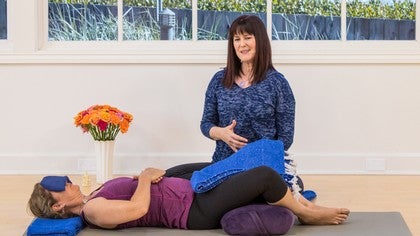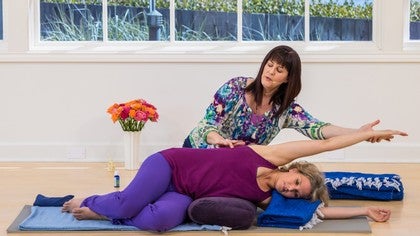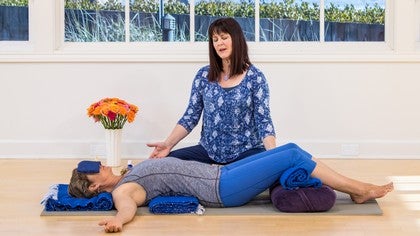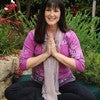Description
About This Video
Transcript
Read Full Transcript
(waves crashing) Namaste. Thank you for joining us. We're sharing today, Mia and I, a practice for peace. And especially if you deal with anxiety. Anxiety's really common for a lot of people and it can take shape in your body and you're being in many different ways.
So accessing peace within through your yoga, through your breath, through touch, and self soothing can be really, really helpful so we're gonna give you a shorter practice that you can connect with the peace within you. So we'll begin with making sure that you have all your props, so gathering your bolster. You'll need a couple of blankets an eye pillow and you have some aromatherapy handy, something with sandalwood, lavender can be good, orange, and there are actually anxiety blends, if you would like to try those. They're pretty wonderful too. So you'll take your first blanket now, and you'll open it length wise like this with the clean edge towards the top of your mat where your head will be, and you'll fold it in in S-shape fold.
It's basically folded in thirds, like an accordion. But you want to make sure it's even and that when you press down on both sides, the blanket is cleanly under all edges. It's not half folded. It lines up really nice and smooth. Then you'll take the top and you'll roll it under.
And this is going to become your head and neck support and you'll smooth it out and you'll see the fringe makes a nice little ramp, which feels really good. And then you'll come to sit in front of this. You'll sit, actually, on the floor, with the fringe right up against your back. And you'll take your bolster and you'll put it where your legs will be, underneath the knees. This is often called a Pranayama support, this folded blanket, or a gentle variation of supported reclining pose because it opens the chest in a gentle way.
It's great for breath work. When you come back, you can support yourself or you can bring your arms up, as you recline back. And once you recline back, you may want to bring that neck and head support under you so it feels just right. And you can take your eye pillow and you can place it over your eyes. And if your anxiety is also connected to trauma, you may not enjoy an eye pillow over your eyes and you may need to keep your eyes open for practice and that's fine.
The good news is the eye pillow does affect the tone of the vagus nerve which is directly connected to our para and pathetic nervous system response. So to relax, it's helpful for that weight over the vagus nerve which is running from the tenth cranial nerve, down across the forehead, across the jaw, the throat. It goes all the way to the belly and that's why a lot of times, when we're stressed too, you know, there can be a holding in the solar plexus, and rushing in the heart, but by either massaging, putting weight on these areas, it can be very helpful. So if you have any trauma or it's not okay to close your eyes in practice, just put that eye pillow or eye bag over your forehead instead of your eyes. And then, as you come into the first few moments of the pose, just notice how you feel, notice how you're doing in this moment.
And began to feel your energy sinking down, grounding, connecting with the earth. From the perspective of Ayurveda, when we're experiencing anxiety and high levels of stress, the energy goes up. It's (speaks quickly), the energy egos up and doesn't ground so these grounding practices are really helpful. We're going to start with prana cleansing angel wings to just move energy out. So if you've been feeling like you've accumulated some stress or some energy, this is an energetic practice with breath and then we're gonna really rest deeply in the supported posture.
So you'll start by bringing your hands over your pelvis, with the palms facing in. And it's as if you're sweeping your energy. As you inhale your arms, your hands float up over your body. And as you exhale, you release anything you're ready to let go of as you sweep your arms out to the sides and down. Drawing a breath in, positive energy coming in, peace.
Exhale, tension, stress, fear, worry. Let it go as you sweep your arms out and down And do this several more times, cleansing your field. Breathing in that which you need. Bringing in that which supports you and soothes you. And breathing out that which doesn't support you, what you're ready to let go of.
Sometimes it's not physical. Sometimes it's a mental state. It can be a thought pattern, that we get hooked into that isn't positive. So a way to work with that is if you find that you go into a fear response, you get triggered into something around a thought, you can choose an opposite thought, an affirmation which is an "I am" statement, such as, "I am peaceful." "I am calm," just opposite to the stressor that you're experiencing in your mind. And these can become mantras that we speak to ourselves.
You can breath in peace and calm. I'm breathing in peace and calm. I'm breathing out anxiety. Just a few more at your own pace. And one last time, breathing in positive energy.
Peace and calm, and then allowing your hands to relax wherever they feel most comfortable. You might enjoy turning the palms up. Or if you feel you need to have your hands on your body, that can be also grounding and helpful when you're feeling anxiety so whatever feels the best to you. Taking a few moments, here, to experience that feeling of grounding. Inviting your energy to move down, moving down.
Sinking into the earth. And feeling the earth like a mother holding you. Mother Earth embracing you, cradling you, protecting you. And so feeling an essence of safety here. You are safe.
And then feeling, as you sink deeper and deeper down, the sense that the earth is rising up to meet you. Feeling your connection to the earth. And feeling your connection to all of life. And resting in that feeling of connection, of oneness. Feeling the peace that washes through you with each breath.
And allowing your breath to gently deepen. Just noticing how open and spacious the front body feels as you take a few deep breaths. And one of the gifts that we can give ourselves when we are experiencing a lot of anxiety or stress or tension in the physical body is to slow down, is to take our time and not rush. Give yourself more time to get to places. Take time to breathe everyday and integrating the self-care practices that are so helpful.
And then when you're ready to transition, you're gonna bend your knees. And you'll slowly draw the knees one at a time up onto the bolster. And then you'll slowly roll all the way off the blanket roll. Your eye pillow, you can just let it fall off, if you like. And then what's important for this next pose is that you turn this blanket, that was under the spine, horizontal now and you bring it under your head.
And just take a few breaths in side lying resting pose. You can draw the knees up high towards the chest, which helps to release the low back after the last pose. And just resting here. There's a self-soothing position that's very helpful for trauma and for anxiety, and that's where you would take your bottom hand to your forehead. And your top hand can go to your heart or to your belly.
And just notice what you feel. You might have had this experience when you were sick as a child where you were soothed by a forehead touch or wash cloth on the forehead. And it's a very, very calming self-soothing touch that you can do for yourself. So taking a few moments to feel the compassion that you have for yourself. Feel the quality of your breath.
And just stay connected to yourself for a few moments here. Just really noticing what you're sensing, what you're feeling. Mindfulness practices, mindful meditation, mindfulness in your your yoga practice is really helpful for calming and centering the mind. And the mind and body are one, so when the mind quiets, the body quiets. And when the body quiets, the mind often follows.
So no matter how you're feeling, come to the mat. Meet yourself with whatever you're experiencing. Be gentle and kind to yourself. Oftentimes, our anxiety will come up when we're going through a really difficult period, so you want to be especially kind to yourself. And then when you're ready, you can take a nice deep breath and slowly make your way onto your back.
And as you come on to your back, you may want to reach up and get your eye pillow and put it over your eyes. And you're welcome to reposition the blanket so it's right under your head. And then this is kind of unusual, you're actually going to take your heel and hook it onto the front of the bolster and you're gonna slide that bolster until it touches your tail bone. And then you're gonna keep your feet on the other side of the bolster, not on top, as we often do in this reclining butterfly. You'll bring your feet together and your knees open so that the outsides of the legs are fully held by the bolster.
Now, if you don't have this flexibility, or for whatever reason this is too strong for you, you can actually flip the bolster on its side, like this, and then do the same thing but just with a little extra support. Feel free to move the bolster on its side if it's feeling too strong to open your legs wide here and you want to make sure it's touching either the outsides of the legs or holding under the knees. And you can reposition and scoot around to find comfort. You can put a blanket over you if you feel cold. And often, a blanket, even just positioned over the pelvis can be really nice to create a feeling of protection around the pelvis and the hips.
And then, of course, if you feel cool, you can place it over you. So we're gonna do a little, again, some self-massage or self-soothing with bringing our hands to our belly. And so you can take your hands one over the other onto your belly. And we're gonna start kind of up high around the solar plexus which many nerves that go into this area and it can really get very tight and activated when we're experiencing anxiety. So you're gonna take a deep breath and as you exhale, you're just gonna gently start to press down into the solar plexus and then slowly, slowly making a circle in a clockwise motion.
So in Chinese medicine, clockwise on the body is tonifying. It gives you energy. But also, if you look at the way our organs are, the descending colon goes down on the left side. Ascending comes up on the right. So this also supports elimination and digestion.
And just relaxing as you do this movement, as you massage your belly. And working out any tight areas. There are some beautiful treatments that are fully based on massaging the abdomen and I am such an advocate for massaging your own belly. If you've had any surgeries, any areas of wounding, make sure that you massage those areas and work out that scar tissue. You want to wait, if it's right after the surgery, four to six weeks, but this can really free up the energy flow in the belly.
And doing this with a nice deep breath is so helpful because the breath also massages the belly. And so you can do as much or as little of the massaging your belly as you like. I also recommend getting your fingers closer in towards the naval and massaging around the naval. And if there's a holding place or a tight place, you can even put a little pressure there. Take a breath.
See if you can get it to relax and then continue. And doing a little bit of a smaller circular motion around the naval. And finding your tight places. Noticing how it feels to massage this area. Feel the abdomen relaxing, the organs softening.
Everybody experiences their stress and anxiety in different ways. Some people it's a pounding of the heart. Some people it's the breath gets very short and shallow. They feel like they can't breathe or can't take a breath. That's where the deep, long exhalations can be really helpful, very good for anxiety.
And a few times a day stopping, bringing your hands to your body, checking in and breathing can start to create a strategy for you to work with on a regular basis to help. And then when you start to feel an anxiety attack coming up, you can go to those things that you know work for you. Getting on the earth, grounding your energy, feeling your feet, massaging, breathing. Good and then when you're done with this, you can slide your hands right up the center of your body and across and over the breastbone, the heart. And if your heart is one of those places that holds anxiety, you might be bringing your hands to your heart and just connecting with your heart.
So this is also a really wonderful place to touch and to connect to if you're feeling your heart is racing. A good affirmation is, everything is alright in this moment. Feeling the peace of this moment, that you are safe in this moment. And then we'll move into placing the blanket over the body, just to make sure that you stay warm and you can either stay in your butterfly. If that's feeling really good to you, maybe you'll just keep your legs here for the final relaxation or you can extend your legs into a straight position for the traditional variation of shavasana or more of a restorative variation.
And then tucking yourself in, making sure you're warm. Good. And letting your Ujjayi breath go if you'd like to at this moment. So that your breath just kind of naturally flows and/or you can keep with your Ujjayi breath or your deep breathing if you would like to continue that, if that's helping you to focus your mind. Taking your aromatherapy, putting a drop in your hand, you can bring your hands together and this releases the scent of the oil.
If you're not using aromatherapy, maybe you'll rub your hands together and do a little massage in the jaw or breathing or anointing. You can also massage the neck, any place that you feel drawn to anoint, to touch, to breath into. So the Ujjayi breath, I also call the Ocean Breath. There's gonna be a nice practice for that as well. It's gonna be a little bit shorter, for those of you that would like to know more how to do the Ujjayi or ocean breathing.
Making sure you feel really tucked in. It can often be nice to visualize yourself wrapped in a cocoon of protective light, that you're wrapped like a blanket in this light that is encompassing your whole physical form in pure energy, in light, in comfort. And then as you soften even more deeply, letting go of any places of holding or tension or gripping in the body. Feel the subtle flow of energy within you. Beautiful streams of energy flowing through your inner landscapes.
Touching even the darkest most fearful places with light. As you feel that light streaming through you, feel yourself connecting even more deeply to the place of peace that resides within. No matter what chaos is happening in the world, or in your personal life, that you can always return back in your meditations and your shavasana, to this place of peace, of stillness, of quiet-tude. Let yourself rest in the essence of peace. You're certainly welcome to stay here for longer or you can begin to travel back from your deep relaxation feeling fully present, awake and aware in your body.
Breathing slowly and deeply as you gently reawaken. Coming back with a deep connection with the peace within you. Feeling relaxed and tranquil. And you can begin to awaken movement. Slowly turning your head from side to side.
You can stretch in whatever way feels good to you. If actually trying your knees towards your chest and rocking from side to side. You'll make your way again on to your side, what ever side feels most comfortable, curling into a little ball and giving yourself a loving embrace. And then as you feel ready, you can make your way slowly to seated. And you'll come back to seated on your bolster or a folded blanket.
Bringing the hands to your heart in anjali mudra. We wish you peace. Namaste.
Therapeutic Yoga: Yoga for Stress, Anxiety, and Grief
Comments
Love the instructions that you give here to self-sooth, breathe, and use touch to stay aware.
Namaste Cheri!

You need to be a subscriber to post a comment.
Please Log In or Create an Account to start your free trial.













